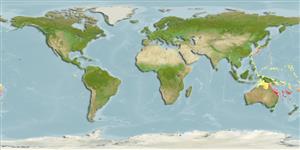Cephalopoda |
Octopoda |
Octopodidae | Octopodinae
Environment: milieu / climate zone / Mức độ sâu / distribution range
Sinh thái học
; Mức độ sâu 1 - 54 m (Tài liệu tham khảo 96968). Tropical
Pacific Ocean.
Length at first maturity / Bộ gần gũi / Weight / Age
Chín muồi sinh dục: Lm ? range ? - ? cm Max length : 32.0 cm TL con đực/không giới tính; (Tài liệu tham khảo 96968); Khối lượng cực đại được công bố: 300.00 g (Tài liệu tham khảo 96968)
Its mantle length is 10 cm (Ref. 96968). Depths range from 1 to 54 m. Occurs on sandy substrates, often associated with coral heads or rubble. Deep lairs are excavated under coral heads or coral rubble on sand substrate. Appears to have crepuscular activity patterns. Lairs are surrounded by cast off gastropod shells which may have been collected for their secondary occupants, hermit crabs. Stomach contents have a high proportion of crustacean exoskeletal fragments. Eggs are laid in large numbers in festoons. The small egg size indicates hatchlings are planktonic. Possibly venomous based on the prominent warning coloration and being locally known as the "poison octopus". Live animals observed to bite objects willingly, uncommon amongst octopuses (Ref. 96968).
Life cycle and mating behavior
Chín muồi sinh dục | Sự tái sinh sản | Đẻ trứng | Eggs | Sự sinh sản | Larvae
Members of the class Cephalopoda are gonochoric. Male and female adults usually die shortly after spawning and brooding, respectively. Mating behavior: Males perform various displays to attract potential females for copulation. During copulation, male grasp the female and inserts the hectocotylus into the female's mantle cavity where fertilization usually occurs. Life cycle: Embryos hatch into planktonic stage and live for some time before they grow larger and take up a benthic existence as adults.
Norman, M.D. and C.C. Lu 2000 Preliminary checklist of the cephalopods of the South China Sea. The Raffles Bulletin of Zoology 8:539-567. (Tài liệu tham khảo 81752)
IUCN Red List Status
(Tài liệu tham khảo 130435: Version 2025-1)
CITES status (Tài liệu tham khảo 108899)
Not Evaluated
CMS (Tài liệu tham khảo 116361)
Not Evaluated
Threat to humans
Human uses
| FishSource |
Các công cụ
Thêm thông tin
Population dynamicsSự sinh trưởng
Max. ages / sizes
Length-weight rel.
Length-length rel.
Length-frequencies
Mass conversion
Sự phong phú
Life cycleSự tái sinh sảnChín muồi sinh dụcSự sinh sảnĐẻ trứngEggsEgg developmentLarvae PhysiologyThành phần ô-xy
Human RelatedStamps, coins, misc.
Các nguồn internet
Estimates based on models
Preferred temperature
(Ref.
115969): 20.4 - 27, mean 25.2 (based on 136 cells).
Fishing Vulnerability
Low vulnerability (22 of 100).
